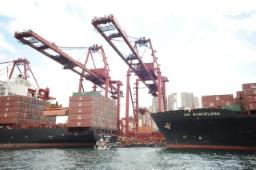 Bigger freight volumes could not lift Zim Integrated Shipping’s earnings, as it posted a wider net loss in 2013 year-over-year.
Bigger freight volumes could not lift Zim Integrated Shipping’s earnings, as it posted a wider net loss in 2013 year-over-year.
The Israeli carrier reported a US$530 million net loss last year from a loss of $428 million in 2012 following a one-time payment for cancelled newbuild contracts and a faster erosion of rates in the last quarter.
In February this year, debt-ridden Zim said it was dropping the contracts for the delivery of three ultra-large container ships that were part of a purchase deal for eight 12,500-TEU vessels that it made with South Korean shipbuilder Samsung Heavy Industries.
Fourth-quarter net loss last year amounted to $282 million from a loss of $238 million in the same quarter a year ago.
Earnings before interest, taxes, depreciation, and amortization were $48 million in 2013 against $108 million in 2012, while revenues in 2013 dropped 7 percent to $3.7 billion from $4 billion in 2012.
The carrier said it managed to slash annual operational losses to $191 million from $206 million in the previous year “in spite of the difficult conditions in the global shipping market and the sharp decrease in freight rates for five consecutive quarters” through technological innovations and a more efficient program of fuel consumption and procurement.
Zim said its average freight rate slid 9 percent to $1,227 per TEU in 2013, even as tonnage rose 5 percent to 2.5 million TEUs.
The shipping line is currently navigating a financial restructuring process with its creditors that it said would “dramatically” improve its finances.
Equally failing to halt growing losses is China Shipping Container Lines (CSCL), which logged a loss of CNY2.65 billion (US$431 million) in 2013 compared to a net profit of CNY524.9 million the previous year.
The Shanghai- and Hong Kong-listed ocean liner attributed the loss to a difficult year beset by a significant imbalance in supply and demand as well as falling freight rates.
“In view of the prolonged operational pressure and the development trend for large-scale container vessels, cooperation between container liners into alliances will be further explored,” it said.




